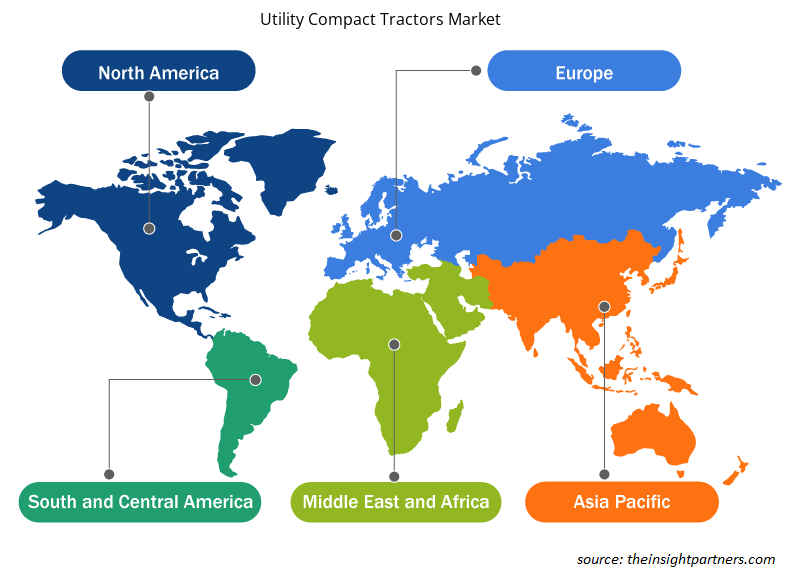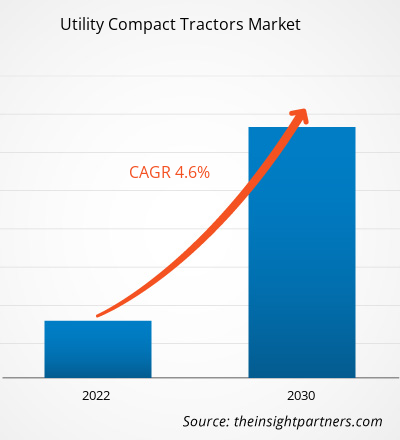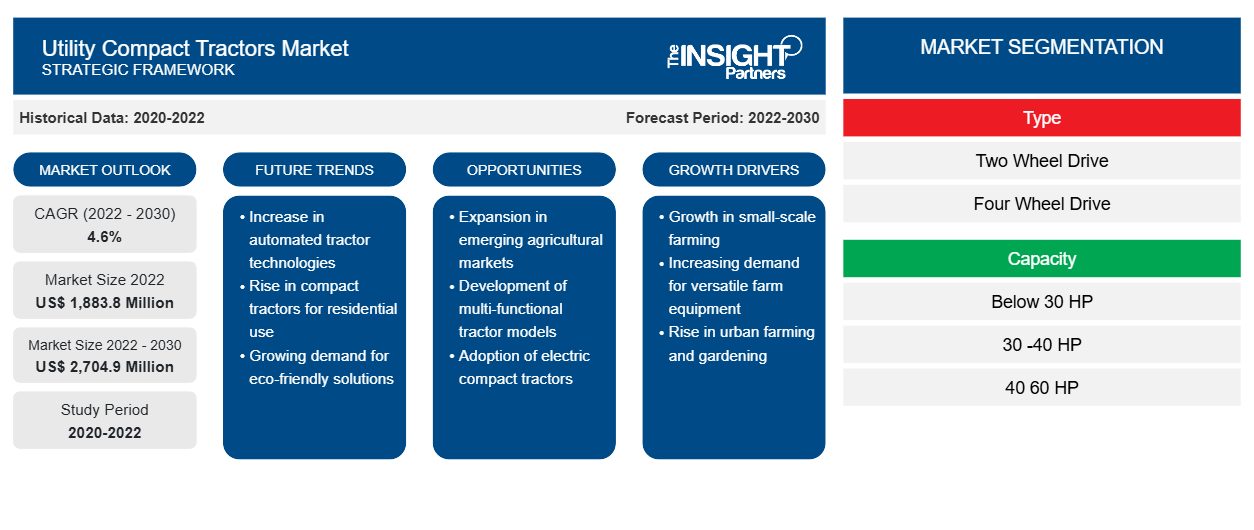[Forschungsbericht] Der Markt für Kompakttraktoren soll von 1.883,8 Millionen US-Dollar im Jahr 2022 auf 2.704,9 Millionen US-Dollar im Jahr 2030 wachsen; von 2022 bis 2030 wird eine durchschnittliche jährliche Wachstumsrate (CAGR) von 4,6 % erwartet.
Analystenperspektive:
Der zunehmende Einsatz von Kompakttraktoren im Bauwesen, in der Landschaftsgestaltung, der Tierhaltung und der Rasenpflege ist ein wichtiger Faktor, der zum Wachstum des Marktes für Kompakttraktoren beiträgt . Diese Traktoren werden zum Heben, Mähen, Schleppen, Transportieren und zur Bodenpflege eingesetzt. Erhöhte Investitionen in Landschaftsbauprojekte und eine expandierende Bauindustrie treiben die Einführung von Kompakttraktoren direkt voran. Laut den von Oxford Economics im Jahr 2023 veröffentlichten Daten wird erwartet, dass der Wert der Bauarbeiten von 9,7 Billionen US-Dollar im Jahr 2022 auf 13,9 Billionen US-Dollar im Jahr 2037 steigen wird, angeführt von riesigen Märkten wie China, den USA und Indien. Indien entwickelt sich zu einer der am schnellsten wachsenden Bausupermächte, während das Vereinigte Königreich voraussichtlich der am schnellsten wachsende Baumarkt in Westeuropa sein wird. Darüber hinaus ist Schneefall in Ländern wie Deutschland, Frankreich, Russland, Norwegen, der Schweiz, Spanien und Schweden ein häufiges Phänomen, und Kompakttraktoren werden häufig bei Schneeräumarbeiten eingesetzt. Im Dezember 2023 kam es in Moskau zu schweren Schneefällen, die den Verkehr beeinträchtigten. Laut Angaben der russischen Regierung wurden rund 20.000 Maschinen, darunter auch Kompakttraktoren, zum Schneeräumen eingesetzt. Der Schneeräumbedarf und die zunehmenden Landschafts- und Bauprojekte führen daher sowohl in Europa als auch in anderen Teilen der Welt zum Einsatz von Kompakttraktoren.
Marktübersicht:
Obwohl Kompakttraktoren eher in der Landwirtschaft eingesetzt werden, werden sie auch im Baugewerbe, im Bergbau, in der Landschaftsgestaltung und beim Rasenmähen verwendet. Im Vergleich zu Traktoren in voller Größe sind diese Traktoren wirtschaftlich und wartungsfreundlich. Darüber hinaus können Kompakttraktoren aufgrund ihres Designs und ihres kompakten, aber leistungsstarken Motors problemlos auf kleinem Raum gehandhabt werden. Kompakttraktoren gibt es mit verschiedenen Antriebsarten, beispielsweise mit konventionellen Verbrennungsmotoren und vollelektrischen Motoren.
Der asiatisch-pazifische Raum wird voraussichtlich lukrative Möglichkeiten für globale und inländische Anbieter von kompakten Nutztraktoren schaffen, hauptsächlich aufgrund des kontinuierlichen Wachstums der Bau- und Bergbauindustrie. Laut den von Oxford Economics im Jahr 2023 veröffentlichten Daten wird erwartet, dass der asiatisch-pazifische Raum bis 2030 7,4 Billionen US-Dollar für den globalen Bausektor erwirtschaften wird. Darüber hinaus wird erwartet, dass die Bergbauaktivitäten aufgrund des kontinuierlichen industriellen Wachstums in der Region in den kommenden Jahren stark zunehmen werden. Somit unterstützt das kontinuierliche Wachstum des Industriesektors letztendlich das Wachstum des Marktes für kompakte Nutztraktoren. Nordamerika und Europa werden in den kommenden Jahren voraussichtlich starke Wachstumsraten auf dem Weltmarkt verzeichnen. Kanada, Deutschland, Österreich, Russland und Schweden haben unter anderem die höchsten Schneefallraten. Darüber hinaus ist die Nachfrage nach Landschafts- und Rasenpflege im Vergleich zu anderen Ländern in den USA hoch. Daher ist die Akzeptanz des kompakten Nutztraktors für Schneeräumungs- und Landschaftsbauaktivitäten in diesen Ländern höher.
Passen Sie diesen Bericht Ihren Anforderungen an
Sie erhalten kostenlos individuelle Anpassungen an jedem Bericht, einschließlich Teilen dieses Berichts oder einer Analyse auf Länderebene, eines Excel-Datenpakets sowie tolle Angebote und Rabatte für Start-ups und Universitäten.
-
Holen Sie sich die wichtigsten Markttrends aus diesem Bericht.Dieses KOSTENLOSE Beispiel umfasst eine Datenanalyse von Markttrends bis hin zu Schätzungen und Prognosen.
Markttreiber:
Wachsende Nachfrage nach Landschafts- und Rasenpflegediensten
Rasenpflegedienste umfassen in der Regel eine breite Palette von Aktivitäten im Zusammenhang mit der Rasen- und Bodenbewirtschaftung sowie deren Instandhaltung. Dazu gehören Mähen, Kantenschneiden, Beschneiden, Düngen, Unkrautbekämpfung, Insektenbekämpfung und Bewässerung. Einige Rasenpflegeunternehmen bieten möglicherweise zusätzliche Dienstleistungen wie Belüftung, Nachsaat und Rollrasenverlegung an. Laut der Analyse von The Insight Partners im Jahr 2022 erreichten die Landschafts- und Rasenpflegedienste im Jahr 2022 etwa 200 Milliarden US-Dollar. Die USA sind einer der Hauptmärkte für Landschafts- und Rasenpflegedienste. US-Verbraucher geben etwa 30 Milliarden US-Dollar für professionelle Landschafts- und Rasenpflegedienste aus. Darüber hinaus sind die staatlichen Ausgaben für die Landschaftsverbesserung ein weiterer Faktor, der der Landschaftsbranche und letztendlich dem Markt für Kompakttraktoren zugutekommt. So kündigte die US-Regierung im Dezember 2023 161 Millionen US-Dollar für Landschaftsrestaurierungsmaßnahmen an. Mit Hilfe dieser Mittel will die Regierung die Restaurierung von 21 Landschaften abschließen. Erhöhte Ausgaben für solche Dienstleistungen treiben die Nachfrage nach Landschaftsgeräten wie Kompakttraktoren an. Daher trägt die gestiegene Nachfrage nach Landschafts- und Rasenpflegediensten erheblich zur Ausweitung des Marktes für Kompakttraktoren bei.
Segmentanalyse:
Die Marktanalyse für Kompakttraktoren wurde unter Berücksichtigung der folgenden Segmente durchgeführt: Typ, Kapazität und Antriebsart. Auf der Grundlage der Kapazität ist der Markt in unter 30 PS, 30-40 PS und 40-60 PS segmentiert. Das Segment 40-60 PS machte im Jahr 2022 mehr als 60 % des Marktanteils der Kompakttraktoren aus.
Kompakttraktoren der Leistungsklasse 40–60 PS werden häufig von Landschaftsgärtnern und Rasenpflegedienstleistern zum Pflügen, Transportieren und für andere Aufgaben eingesetzt. Die Produktentwicklungsaktivitäten der Hersteller von Kompakttraktoren treiben den Marktfortschritt weiter voran. So brachte Kubota im Februar 2023 seinen Kompakttraktor LX4020 mit 40 PS auf den Markt. Das Modell verfügt über eine breitere Achse, die die allgemeine Manövrierfähigkeit erhöht und es damit für Landschafts- und Rasenpflegearbeiten geeigneter macht.
Regionale Analyse:
Der geografische Umfang des Marktberichts für kompakte Nutztraktoren umfasst Nordamerika (USA, Kanada und Mexiko), Europa (Spanien, Großbritannien, Deutschland, Frankreich, Italien und Rest von Europa), Asien-Pazifik (Südkorea, China, Indien, Japan, Australien und Rest von Asien-Pazifik), den Nahen Osten und Afrika (Südafrika, Saudi-Arabien, Vereinigte Arabische Emirate und Rest von Nahem Osten und Afrika) sowie Süd- und Mittelamerika (Brasilien, Argentinien und Rest von Süd- und Mittelamerika). Der nordamerikanische Markt für kompakte Nutztraktoren ist in die USA, Kanada und Mexiko unterteilt. Die Landschafts- und Rasenpflegebranche in Ländern wie den USA, Kanada und Mexiko treibt die Nachfrage nach kompakten Nutztraktoren maßgeblich an.
Aufgrund der stetigen Expansion der Landschafts- und Bauindustrie wird erwartet, dass Nordamerika in den kommenden Jahren weiterhin den Marktanteil von Kompakttraktoren dominieren wird. Die Bauindustrie leistet einen bedeutenden Beitrag zur US-Wirtschaft. Im ersten Quartal 2023 gab es im Land etwa 919.000 Bauunternehmen, die jedes Jahr Bauprojekte im Wert von etwa 2,1 Billionen US-Dollar abschließen. In Kanada war der Bausektor im Jahr 2022 der sechstgrößte Beitragszahler zum BIP. Die kanadische Bauindustrie erwirtschaftete im Jahr 2022 einen Jahresumsatz von rund 250 Milliarden US-Dollar. Neben der Nachfrage aus dieser Branche sind die starken Schneefälle in den kanadischen Bundesstaaten ein bemerkenswerter Faktor, der die Einführung von Kompakttraktoren vorantreibt. In den USA dürften die zunehmende Präferenz für Kohlenstoffemissionen und die zunehmende Einführung von Elektrofahrzeugen im kommenden Jahr neue Markttrends für Kompakttraktoren mit sich bringen.
Regionale Einblicke in den Markt für Kompakttraktoren
Die regionalen Trends und Faktoren, die den Markt für Kompakttraktoren im Prognosezeitraum beeinflussen, wurden von den Analysten von Insight Partners ausführlich erläutert. In diesem Abschnitt werden auch Marktsegmente und Geografien für Kompakttraktoren in Nordamerika, Europa, im asiatisch-pazifischen Raum, im Nahen Osten und Afrika sowie in Süd- und Mittelamerika erörtert.

- Erhalten Sie regionale Daten zum Markt für Kompakttraktoren
Umfang des Marktberichts über Nutzfahrzeug-Kompakttraktoren
| Berichtsattribut | Details |
|---|---|
| Marktgröße im Jahr 2022 | 1.883,8 Millionen US-Dollar |
| Marktgröße bis 2030 | 2.704,9 Millionen US-Dollar |
| Globale CAGR (2022 - 2030) | 4,6 % |
| Historische Daten | 2020-2022 |
| Prognosezeitraum | 2022–2030 |
| Abgedeckte Segmente |
Nach Typ
|
| Abgedeckte Regionen und Länder |
Nordamerika
|
| Marktführer und wichtige Unternehmensprofile |
|
Marktteilnehmerdichte für Kompakttraktoren: Auswirkungen auf die Geschäftsdynamik verstehen
Der Markt für Kompakttraktoren wächst rasant, angetrieben durch die steigende Nachfrage der Endnutzer aufgrund von Faktoren wie sich entwickelnden Verbraucherpräferenzen, technologischen Fortschritten und einem größeren Bewusstsein für die Vorteile des Produkts. Mit steigender Nachfrage erweitern Unternehmen ihr Angebot, entwickeln Innovationen, um die Bedürfnisse der Verbraucher zu erfüllen, und nutzen neue Trends, was das Marktwachstum weiter ankurbelt.
Die Marktteilnehmerdichte bezieht sich auf die Verteilung der Firmen oder Unternehmen, die in einem bestimmten Markt oder einer bestimmten Branche tätig sind. Sie gibt an, wie viele Wettbewerber (Marktteilnehmer) in einem bestimmten Marktraum im Verhältnis zu seiner Größe oder seinem gesamten Marktwert präsent sind.
Die wichtigsten auf dem Markt für Kompakttraktoren tätigen Unternehmen sind:
- YANMAR Traktor
- Mahindra
- TYM CORPORATION
- Solectrac
- John Deere
Haftungsausschluss : Die oben aufgeführten Unternehmen sind nicht in einer bestimmten Reihenfolge aufgeführt.

- Überblick über die wichtigsten Akteure auf dem Markt für Nutzfahrzeug-Kompakttraktoren
Schlüsselspieleranalyse:
Bobcat Company, Mahindra Tractors, Kubota, John Deere, Massey Ferguson, TYM, Yanmar und New Holland gehören zu den führenden Akteuren, die im Marktbericht für Kompakttraktoren vorgestellt werden. Darüber hinaus wurden im Rahmen dieser Marktforschungsstudie mehrere andere wichtige Unternehmen untersucht und analysiert, um einen umfassenden Überblick über den Markt zu erhalten.
Aktuelle Entwicklungen:
Anorganische und organische Strategien wie Fusionen und Übernahmen werden von Unternehmen auf dem Markt für Kompakttraktoren häufig eingesetzt. Nachfolgend sind einige aktuelle Entwicklungen der wichtigsten Marktteilnehmer aufgeführt:
Jahr |
Nachricht |
Region |
|
März 2023 |
TYM hat die neue Serie von 4 Traktoren mit Telematiksystem (nur T76) und hydraulischen Oberlenkern auf den Markt gebracht. |
Asien & Pazifik |
|
Juni 2023 |
John Deere hat die Verbesserungen für das Modelljahr 2024 für seine Kompakttraktoren der Serien 3R und 4 vorgestellt. Diese Traktoren sind mit Zubehör ausgestattet, das für die gewerbliche Schneeräumung nützlich ist. |
Nordamerika |
- Historische Analyse (2 Jahre), Basisjahr, Prognose (7 Jahre) mit CAGR
- PEST- und SWOT-Analyse
- Marktgröße Wert/Volumen – Global, Regional, Land
- Branchen- und Wettbewerbslandschaft
- Excel-Datensatz
Aktuelle Berichte
Erfahrungsberichte
Grund zum Kauf
- Fundierte Entscheidungsfindung
- Marktdynamik verstehen
- Wettbewerbsanalyse
- Kundeneinblicke
- Marktprognosen
- Risikominimierung
- Strategische Planung
- Investitionsbegründung
- Identifizierung neuer Märkte
- Verbesserung von Marketingstrategien
- Steigerung der Betriebseffizienz
- Anpassung an regulatorische Trends























 Kostenlose Probe anfordern für - Markt für Kompakttraktoren
Kostenlose Probe anfordern für - Markt für Kompakttraktoren